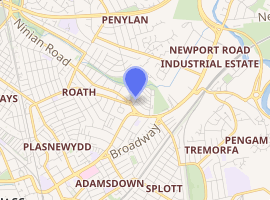St Margaret's Church, Roath
St Margaret's Church (dedicated to St Margaret of Antioch) is a nineteenth-century Church in Wales parish church in the suburb of Roath, Cardiff, Wales. It includes the mausoleum of the Marquises of Bute.
| St Margaret of Antioch | |
|---|---|

| |
| Denomination | Church in Wales |
| Previous denomination | Roman Catholic |
| History | |
| Status | Active |
| Founded | 11th century |
| Dedication | St Margaret of Antioch |
| Architecture | |
| Functional status | Mother church |
| Heritage designation | Grade I |
| Designated | 19th May 1975 |
| Architect(s) | John Prichard |
| Completed | 1870 (tower 1926) |
| Specifications | |
| Number of spires | none |
| Materials | Stone |
| Bells | 1 |
| Administration | |
| Parish | Roath |
| Diocese | Diocese of Llandaff |
History
A church dedicated to St Margaret existed in Roath since the medieval period. It was a small Perpendicular style building with a bell-turret at the western end.[1] In 1800 a mausoleum was added, for the Marquises of Bute.[2] The church was completely demolished in 1868 to make way for a new replacement.[1]
The new church was completed, with a cruciform plan in a Decorated Gothic style.[1] The plan had been designed by Alexander Roos, architect to the Butes. The above ground church was designed by architect John Prichard and financed by John Crichton-Stuart, 3rd Marquess of Bute, who dismissed Roos when he came of age in 1868.[3] A wide variety of coloured bricks and coloured stone was used to decorate the internal walls, in red, blue, white, grey-green and pink.[3] The church tower (without the spire envisaged by Prichard) was designed later by John Coates Carter and completed in 1926.[3]
The glasswork of the church's east window was destroyed in a bomb-blast during the Second World War. The present glass, dating from 1952, depicts the Ascension of Jesus, flanked by the patron saints of the four daughter churches: St Edward's, St Anne's, St Agnes's and St Philip's. Of these churches, only St Edward's still holds a daughter position. St Agnes's closed in 1966 and St Anne's in 2015. St Philip is still an operational church, but is no longer in the parish after the boundaries were adjusted in the late 20th century.[4]
Bute mausoleum
An ornate north aisle chapel was added to the church between 1881 and 1886,[2] as the new mausoleum for the Bute family tombs.[1] Seven large sarcophagi in red granite, were added to contain the remains of the members of the Bute family who had been interred in the previous church.[6] The original stone memorial plaques were included in the new tombs.
Those interred in the sarcophagi are:[6]
- Charlotte Jane Windsor, Marchioness of Bute (1746–1800) – first wife of the first Marquess.
- John Stuart, 1st Marquess of Bute (1744–1814)
- Frances Coutts, Dowager Marchioness of Bute (1773–1832) – second wife of the first Marquess.
- John Stuart, Lord Mount Stuart (1767–1794)
- Gertrude Amelia Stuart (died 1809) – widow of Lord Henry Stuart.
- Lord Henry Stuart (1777–1809) – a son of the first Marquess and Charlotte.
- Elizabeth Penelope Stuart (1819–1822) – daughter of Lord James Stuart.
Daughter Churches
St Margaret's now has only one daughter church, this being the nearby St Edward's on Blenheim Road. It formerly had several others:
- St Francis, Splott, opened in 1894, stood on Singleton Street and was built primarily to serve the workers of the copper, steel and ironworks of the East Moors area. It closed in 1969.
- St Agnes, Roath, opened in 1886, served the area south of Broadway. It was later transferred to the Parish of St German's. Its altar is now in St Mary's Butetown.[7] It closed in 1966, though the name survives as a chapel in St German's, where its war memorial, is now located.[8]
- St Anne's, Roath opened in 1887. It closed in 2015.
- St Philip's, Tremorfa was founded in 1930 to serve what was then a new council estate. It was originally a hall, which was replaced in 1937 by a tin tabernacle which had itself formerly been St Joseph's, Heath and also St Alban's, Splott, both of which had been replaced by permanent buildings. It was replaced by a permanent building in 1966. It was separated from the Parish of Roath in the late 20th century and has been partnered with St Mark's, Gabalfa since 2004.
Gallery
 Interior of St Margaret's
Interior of St Margaret's Bute Mausoleum
Bute Mausoleum St Philips, Tremorfa
St Philips, Tremorfa
References
- Memorial Inscriptions: Roath Church, British History Online (from Cardiff Records, Volume 3 John Hobson Matthews (ed.), 1901, pp. 545–552). Retrieved 22 August 2013.
- Lynn F. Pearson, Mausoleums, Shire Publications Ltd. (2002), page 39. ISBN 0 7478 0518 0
- Diane A. Walker, 'A Guide to the Parish Church of St Margarets, Roath', Vicar & Churchwardens of the Parish of Roath (1994), pages 1–2. ISBN 978-0-9523835-0-5
- Rose, J. 'Cardiff Churches Through Time'. Amberley, 2013, p.19. ISBN 9781445610924
- Church of St Margaret, Penylan, britishlistedbuildings.co.uk, retrieved 22 August 2013
- Diane A. Walker, 'A Guide to the Parish Church of St Margarets, Roath', Vicar & Churchwardens of the Parish of Roath (1994), pages 10–11. ISBN 978-0-9523835-0-5
- "Flat Holm, Cardiff St Mary's". Retrieved 11 March 2018.
- "IWM". Retrieved 11 March 2018.